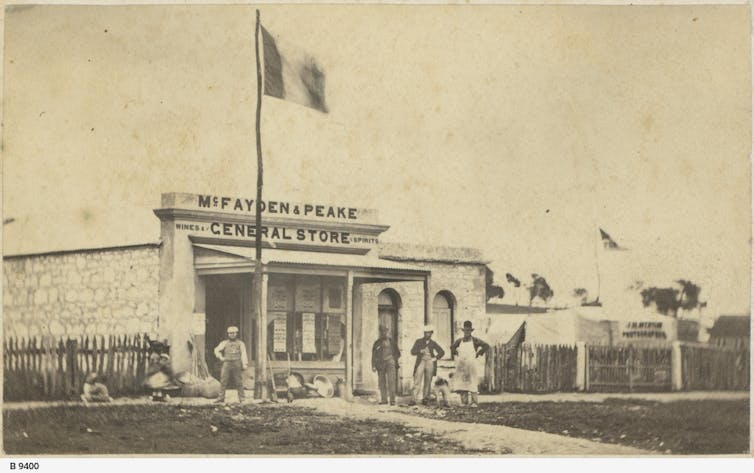how Riverdance shaped Irish dance, and reflected a multicultural Australia
- Written by Jeanette Mollenhauer, Honorary Fellow (Dance), Faculty of Fine Arts & Music, The University of Melbourne

Ireland won the 1994 Eurovision Song Contest, but their victory was overshadowed by the seven-minute interval “filler” that received a standing ovation.
The combined talents of Jean Butler, Michael Flatley and their supporting cast showcased Irish dance in a new, exciting way in an item called Riverdance. And the world – including Australia – took notice.
Thirty years later, Riverdance still circles the globe, with several troupes touring in different locations. So, does Riverdance matter in Australia? Yes, I believe it does.
The Irish in Australia
Australia has had a significant Irish-heritage population[1] since the 1788 arrival of the First Fleet.
Throughout the 19th century, signs saying “No Irish Need Apply” were common[2] in job advertisements.
The 20th century saw some improvement, but comedians continued to promote[3] the idea Irish people had low intelligence and were often drunk.
Performing or watching Irish dance was a way of sticking together and celebrating Irishness. Records of Irish dance in Australia date back to the early 19th century, with the first mention of an Irish dancing teacher in Sydney in an Australian newspaper published in 1829[5].
The folk music revival of the 1960s and ‘70s, when Irish artists such as The Chieftains became globally popular, brought positive change to perceptions of Irish people both here and worldwide[6].
Riverdance themes of migration and feelings of longing for the former homeland struck a chord[9] with Australians who have Irish heritage, and there was a surge in popularity[10] of Irish dance.
An evolving dance form
Riverdance showed “traditional” does not have to mean “frozen in the past”; traditional dance can be adapted for modern audiences.
Irish dance has always been a malleable art form. While there is evidence of it in the 17th century[11], most records date from the 19th century when it became competitive.
A video from 1929[12] shows dancers keeping their feet low and dancing within a small space.
By the 1980s[13], the style was more athletic, with the feet sometimes coming above knee level.
In 1994, Riverdance put a whole lot of new ideas into the seven-minute performance.
One important change was Flatley bursting onto the stage using his arms in a way never seen before in competition dancing. Until then, dancers kept straight arms by their sides. Suddenly, restraint was blown away.
Traditionally males wore kilts in competitions, which did little to attract boys to Irish dance either in Ireland or Australia. The Riverdance men wore black trousers. Irish dance was depicted as an activity in which men and boys can participate, excel at – and even look sexy while performing.
The women also wore new outfits. Instead of restrictive heavy competition costumes, Riverdance put women into short, body-hugging dresses.
The first full-length production of Riverdance was performed in Dublin in 1995, and first toured Australia in March 1997[14].
Most elements of Riverdance have remained constant since those first performances. But the cast has changed many times and is now truly international, including Morgan Bullock[15], the first African American cast member.
But while Riverdance is very similar to its first performances, the popularity of the production has led to changes in Irish dance.
Riverdance resulted in higher enrolments in Irish dance classes in both Ireland[16] and Australia[17].
The larger numbers of competitors has driven many changes in the style of competition dancing because the more dancers there are, the more difficult it is to win. Competitors are increasingly introducing new elements – such as more complex steps and innovatively designed costumes (within prescribed competition guidelines) to attract the judges’ attention[18].
A multicultural artform
People of all ages and cultural backgrounds filled Margaret Court Arena, Melbourne, last month when I attended a performance. Riverdance stills draws large audiences 30 years on, provides a rare opportunity for Australians to witness a culturally-specific dance on a concert stage.
Many immigrant communities in Australia have dance groups and generally, group members belong to that community. Until the mid-1990s, Irish dance behaved the same way; it remained within[19] the Irish community.
Post-Riverdance, that cultural boundary fell away: anyone[20] could learn Irish dance and excel at it.
At 30, Riverdance still demonstrates the spirit of multiculturalism: one of the many cultures in Australia’s population being publicly celebrated, with numerous Australian dancers having been in the cast over the years.
Riverdance matters in Australia because it weaves a thread into Irish-Australian history and attracts many people to the art of dance, as performers and audience members. While other dance works come and go on the world’s concert stages, Riverdance has been a constant presence for three decades.
It is still unmistakably Irish dance but is performed and witnessed by people from many backgrounds. A rare feat, indeed.
References
- ^ significant Irish-heritage population (www.nma.gov.au)
- ^ were common (unsw.press)
- ^ comedians continued to promote (unsw.press)
- ^ State Library of South Australia (collections.slsa.sa.gov.au)
- ^ published in 1829 (trove.nla.gov.au)
- ^ worldwide (www.routledge.com)
- ^ Blacktown City Libraries (blacktownmemories.recollect.net.au)
- ^ CC BY-NC-SA (creativecommons.org)
- ^ struck a chord (www.tandfonline.com)
- ^ surge in popularity (intellectdiscover.com)
- ^ the 17th century (www.bbc.com)
- ^ video from 1929 (www.youtube.com)
- ^ By the 1980s (www.youtube.com)
- ^ in March 1997 (riverdance.com)
- ^ Morgan Bullock (www.usatoday.com)
- ^ Ireland (berghahnbooks.com)
- ^ Australia (intellectdiscover.com)
- ^ attract the judges’ attention (www.cambridge.org)
- ^ remained within (www.cambridge.org)
- ^ anyone (www.tandfonline.com)

















